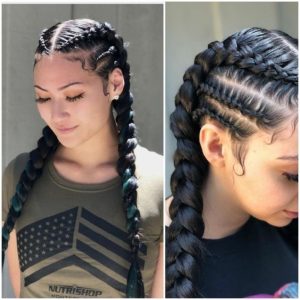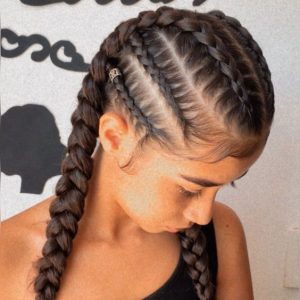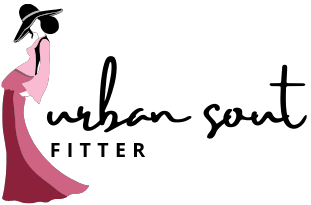Who Invented Braids
Braids have a fascinating history dating back 5000 years in African culture, reaching as far as 3500 BC, and were particularly embraced by women. The origins of braiding can be traced to the Himba people of Namibia in Africa, where this timeless tradition has flourished for centuries. The Himba people have been intricately braiding their hair, contributing to the rich tapestry of this cultural practice.
Braids have been used for both functional and decorative purposes, such as keeping hair neat and out of the way, as well as for cultural, traditional, and artistic expression. They have been a part of human grooming and fashion for centuries and continue to be popular today in various forms and styles. Read more: Native American Models
The Historical Origin of Braids

Ancient Origins
Braids have a history that dates back thousands of years. They were first seen in various ancient civilizations, including Egypt, India, and China. These early braids served both functional and decorative purposes. They were used to keep hair clean, neat, and manageable while also signifying social status and cultural identity.
African Influence
Africa has a rich tradition of intricate braiding styles. In many African cultures, braids were not only a form of self-expression but also a means of communication. Different braid patterns could convey one’s age, marital status, social rank, and even religious beliefs. The intricate and diverse braiding techniques of Africa continue to influence braiding styles around the world.
Native American Braiding
Native Americans also had their unique braiding traditions. Tribes such as the Cherokee and Apache used braids to represent their cultural heritage, with each tribe having distinct braiding patterns and techniques.
The concept of braids is ancient and widespread, making it challenging to attribute their invention to a single individual or culture. It’s safe to say that braids evolved independently across different civilizations, shaped by the unique needs and preferences of each society.
Evolution of Braiding Techniques
Early Techniques
Early braiding techniques involved weaving hair together using simple tools like fingers, sticks, or bone combs. These techniques were often passed down through generations and adapted to regional customs. Discover: How to dress over 60 and overweight
Modern Braiding
In modern times, braiding has evolved significantly. The introduction of innovative tools and products, such as hair extensions and specialized braiding hair, has enabled more complex and varied braiding styles. The craft of braiding has become an art form, with professional braiders specializing in intricate designs.
Cultural Significance of Braids
Braids hold immense cultural significance worldwide. They are more than just a hairstyle; they are a reflection of history, heritage, and identity. For many, braids represent a sense of belonging, pride, and tradition.
Famous Figures in Braiding History
Traditional African Braiders
Throughout history, certain individuals became renowned for their braiding skills, passing down their knowledge and expertise to future generations. These traditional African braiders were respected members of their communities.
Influence on Pop Culture
In the 20th and 21st centuries, braids made their way into pop culture, thanks to influential figures like Bo Derek, who popularized “Bo Braids,” and celebrities like Beyoncé, who regularly sport different braided styles in music videos and on the red carpet.
Different Types of Braids
Braids come in a multitude of styles and variations. Some popular types include:
- Box Braids
- French Braids
- Cornrows
- Dutch Braids
- Fishtail Braids
- And many more
Braids in the Fashion Industry
Braids are not confined to everyday life; they have also played a significant role in the fashion industry. Models and fashion designers have showcased various braided hairstyles on runways, emphasizing the versatility and beauty of braids.
Braids in the 21st Century
In the 21st century, braids have gained even more prominence, with people from all backgrounds embracing this timeless hairstyle. Social media has further fueled the popularity of braids, with countless tutorials and inspiration available online.

Maintaining braided hair is crucial for its longevity and health. Regular washing, conditioning, and moisturizing are essential to prevent breakage and keep your braids looking fresh.
Common Misconceptions About Braids
Many myths and misconceptions surround braided hair, such as the belief that braids inhibit hair growth. We will debunk these misconceptions and provide accurate information on the subject.
The Art of Braiding
Braiding is a skill that requires practice and patience. It’s an art form that allows individuals to express their creativity and style. Embrace the art of braiding and discover the joy of creating beautiful, intricate designs.
Want to try braiding at home? We’ll share Who invented braids and some DIY braiding tips, from basic styles to more advanced techniques, to help you get started.
Conclusion
In conclusion, those Who invented braids have a rich history that spans across continents and cultures. They have evolved from simple, functional styles to intricate works of art. Today, braids continue to be a symbol of identity, self-expression, and beauty.
FAQs
Q. Are braids suitable for all hair types?
Yes, braids can be adapted to various hair types, though the techniques and products used may differ.
Q. Can braids cause hair damage?
When done correctly and maintained properly, braids should not cause hair damage. However, if they are too tight or not cared for, they can lead to breakage.
Q. How long do braids typically last?
The duration of braids depends on factors like the braid type and hair care but can generally last from a few weeks to a few months.
Q. Can I wash my hair with braids?
Yes, you can wash your hair with braids, but it’s essential to follow the right washing and drying techniques to maintain their integrity.
Q. Can I sleep with braids in my hair?
Sleeping with braids is possible, but it’s recommended to protect them with a satin scarf or pillowcase to prevent friction and frizz.
